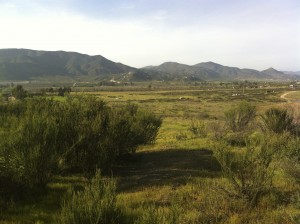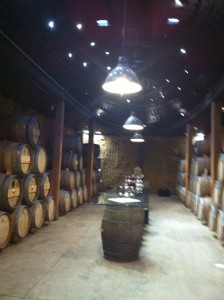When we left San Diego, we decided to head east and cross the border at Tecate instead of Tijuana. We’ve had much better experiences crossing here, especially when we’re headed back to the US as I don’t think we’ve ever taken any less than three hours going north at Tijuana versus a half hour, at maximum, at Tecate.
We were hoping to get the air conditioning compressor changed on the Lincoln LS in Tecate, but were directed to the Ford dealership in Ensenada instead. Mom and I weren’t uncomfortably hot in the car, but we knew it was going to get much warmer as we continued south.
The road from Tecate to Ensenada is called the Wine Route or “Ruta del Vino” and connects over 50 wineries in the state of Baja California. Although few people think of wine in Mexico, it is actually the oldest wine-growing region in North America (and yes – Mexico IS part of North America!) and have produced wine since the sixteenth century when the Spaniards arrived with vine clippings from the old country. The Wine Route takes you through four different valleys (Guadalupe, Llano Colorado, Santo Tomas and San Vicente) and provides a Mediterranean microclimate that is in the midst of a tourism and winemaking renaissance that Napa Valley experienced in the 1970’s and that the Okanagan Valley in southern British Columbia in Canada has recently experienced.
Besides the stunning scenery, the Baja wine country offers a wide range of world-class restaurants, B&B’s, and luxury hotels and it’s developing more every year. If Mexico is able to get the drug war under control and make the border towns safe again, we expect the tourism in this area to expand tremendously over the next decade with visitors from the US and beyond. In the meantime, we’re savoring every trip though this region and realize the potential of what will continue to develop over time.
Unfortunately, because we were anxious to get the car repaired and the weekend was upon us (most businesses close at 1:00 on Saturday and don’t open again until Monday in Mexico), we had to hurry on to Ensenada on this trip and not explore what the wine country had to offer. I hope that we have more time the next drive down with Mom.
We checked into the Hotel Mision Santa Isabel, a once-beautiful property, but quickly realized that this hotel is a sad memory of its former self. It is perfectly situated, however, and provided close and safe access to good restaurants and shopping. Next time, however, we would stay at the Hotel Cortez across the street (www.bajainn.com) as it appeared very well cared for and they served us a delicious breakfast the next morning.
Mom loves horses and we took a horse drawn buggy down the main thoroughfare to the Telcel location to get our Mexican phones working, got the car fixed at the local Ford dealership and finally got our convoy on the road for the next leg of our Baja journey.



